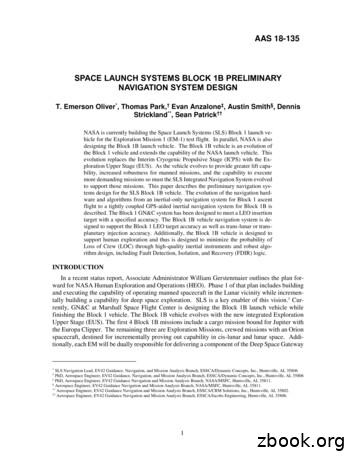Combined Inertial Navigation System (Ins Gps)
COMBINED INERTIALNAVIGATION SYSTEM(INS GPS)RPE HARTRON-ARKOS, UkraineHartron-Arkos Proprietary
Perspectives of launch services market developmentEuropean current familyof launcherEuropeancurrent familyof launcherGuidelines of eanlauncher family development1. Guarantee ofEuropeanspace ofaccess1. GuaranteeuntilEuropean2025. space accessuntil 2025.2. Launch service costreductionwithservicethe cost2. Launchfunctionalitykeeping.reduction with thefunctionality keeping.3. Existing launchersperformancesextension3. Existing launchersby itsmodernization.performances extensionby its modernization.Problems of the launchservices market:Problemsof the launchservices market:1.Launch services highprice.1.Launch services highWays to achieve theclaimedWays togoals:achieve theclaimed goals:1.Design of new kinds ofpropulsions.1.Design of new kinds ofpropulsions.2. Development ofmoderncompositesofand2. Developmentfuels.modern composites andfuels.3. GNC modernization(implementationof3. GNC eptions)new approaches andconceptions)price.2.Saturation of the marketby thedifferent types2.Saturationof theofmarketlaunchersandthereforeby the different types highofcompetitiveness.launchers and therefore highcompetitiveness.2
Launcher’s GNC Modernization using Combined InertialNavigation SystemCombined Inertial NC modernizationGNC modernizationGNC SoftwareoptimizationGNC SoftwareoptimizationThe usage of the CombinedInertialNavigationThe usageof theSystemCombinedbasedonINSand GPSSystemwillInertial Navigationallowtoincreasethebased on INS and GPS willaccuracyallow ofto navigationincrease theparametersdeterminationaccuracyof navigationconsiderably.parametersdeterminationGNC HardwaremodernizationGNC Hardwaremodernizationconsiderably.System conceptAdvantages:Advantages:1. Considerable accuracyincreasingof navigation1. ingof navigationand,therefore, determinationincreasing ofparameterstheand,wholeGNCtherefore, increasing ofperformances.the whole GNCperformances.2. Decreasing of theaccuracyrequirements2. Decreasingof the of themainINS,whichallowsto of theaccuracy requirementsusemainmoreINS,cheaperwhich allows tocomponents.use more cheapercomponents.3. Possibility of the Europeannavigationsystem3. Possibilityof “Galileo”the Europeanusage.navigation system “Galileo”usage.3
Short outline / Proposal concept IObjective of the proposal:Objective of the proposal:The objective of the proposal is a combination of the existing inertial navigation systemThe withobjectivethe proposalis acombinationthe existinginertial for moreofaccuratenavigationthe launchers.(INS)with globalposition(GPS)for more softwareaccurate packagenavigationof hardwarethe launchers.Theproject’sproductwill ndhardwareunits.As we know, in Europe this problem is not solved yet, because European launchers useAs weknow,in Europethis problem is not solved yet, because European launchers useonlyinertialnavigationsystem.only inertial navigation system.Impact:Impact:If the project is implemented, the accuracy of European launcher’s navigationIf the project is implemented, the accuracy of European launcher’s navigationsystem will improve. Also, it would be able to use the European satellitesystem will improve. Also, it would be able to use the European satellitenavigation system “Galileo” in the commercial application.navigation system “Galileo” in the commercial application.4
Short outline / Proposal concept IIShort introduction into the state-of-the-artShort introduction into the state-of-the-artNowadays all known launchers use high accuracy INS, based on technology of strapNowadaysall knownlaunchersuseexpensivehigh accuracyINS,basedof strapdownINS. Thesesystemsare quiteand atoncetheyondotechnologynot solve thetask eydonotsolvetheminimization of instrumental errors completely. Therefore this problem continues totaskbe ofminimizationurgentnow. of instrumental errors completely. Therefore this problem continues to beurgent now.Scientific / technological aims of the project exceeding the state-of-the-artScientific / technological aims of the project exceeding the state-of-the-artBusiness aim of the project is reducing the cost of navigation system using by theBusinesslaunchers.aim of theIt projectis reachedreducingbytheusingcost moreof navigationusing bytheGPSEuropeancould becheapersystemINS togetherwithEuropeanforlaunchers.could beAnotherreachedaimby usingmorecheaperINS togetherGPSnavigationthe best Itaccuracy.is usageof theEuropeansatellite withnavigationnavigationfor thebestcommercialaccuracy. Anotheraim is usage of the European satellite navigationsystem“Galileo”in theapplication.system “Galileo”in thecommercialapplication.Scientificaim of theprojectis synthesisof combined inertial navigation system, whichScientificaimoftheprojectissynthesisof combined inertial navigation system, whichcould be implemented for any types of launchers.could be implementedfor any typesof launchers.Technologicalaim is developingtechnologyof combined inertial navigation systemTechnologicalaimisdevelopingtechnologyof combined inertial navigation systemdesign.design.5
FP7 ConsortiumLEADINGCOMPANY(DLR, CNES)FP7CONSORTIUMRPEHARTRON-ARKOS(Ukraine)ELV S.p.a.(Italy)6
CONTACTSOleksandr LukyanovychLeading scientistResearch Production Enterprise HARTRON-ARKOS LTDAddress: Academika Proskury str. 1, Kharkov, 61070 UkraineE-mail:sash74@mail.ruPhone: 38 057 719 47 79 (office) 38 067 957 04 28 (mobile)Fax: 38 057 315 43 497
only inertial navigation system. Objective of the proposal: The objective of the proposal is a combination of the existing inertial navigation system (INS) with global position system (GPS) for more accurate navigation of the launchers. The project's product will be navigation algorithms software package and hardware units.
Redundant Inertial Navigation Unit (RINU) The RINU is a redundant inertial navigation system manufactured by Honeywell International, Inc (HI). The RINU is derived from the Fault Tolerant Inertial Navigation Unit (FTINU) INS previously flown on the Atlas V launch vehicle. The RINU features a redundant set of five inertial instruments channels.
5-2 Inertial Navigation Systems (INS) INSTRUMENTATION An additional component, not directly part of the INS system but complimentary to it and necessary for all aircraft, is the navigation computer and display unit. Most aircraft now fly using triplicate components for safety and reliability. A common aircraft fit would include: 3 INS systems
2.2 Fundamentals of Inertial Navigation, 19 2.2.1 Basic Concepts, 19 2.2.2 Inertial Navigation Systems, 21 2.2.3 Sensor Signal Processing, 28 2.2.4 Standalone INS Performance, 32 2.3 Satellite Navigation, 34 2.3.1 Satellite Orbits, 34 2.3.2 Navigation Solution (Two-Dimensional Example), 34 2.3.3 Satellite Selection and Dilution of Precision, 39
Inertial Sensors, Precision Inertial Navigation System (PINS). 1 Introduction Presently Inertial Navigation Systems are compensated for gravitational acceleration using approximate Earth gravitation models. Even with elaborate model based gravitation compensation, the navigation errors approach upto several hundred
Inertial Navigation System (AINS) consists of an inertial navigation system (INS), Doppler velocity log, depth meter and intermittent DGPS fixes. The data acquired are fused by an extended Kalman filter. After preliminary tests, this navigation system will be installed on an Autonomous Underwater Vehicle (AUV) where it will
Visual Inertial Navigation Short Tutorial Stergios Roumeliotis University of Minnesota. Outline . "Visual-inertial navigation: A concise review," IRA'19. Introduction Visual Inertial Navigation Systems (VINS) combine camera and IMU . Continuous-time System Equations: Quaternion of orientation: Rotation matrix: Position: Velocity
Inertial sensors used in the mechanization of Newton's laws of motion, hereafter called the inertial navigator or inertial navigation system (INS), are gyroscopes and accelerometers. The gyroscopes sense angular orientation or motions of the vessel. The accelerometers sense the vessel's linear accelerations, which are changes in linear
API 541 5th Edition - Scope This standard covers the minimum requirements for special purpose form-wound squirrel-cage induction motors 375 kW (500 Horsepower) and larger for use in petroleum, chemical and other industry applications. Note 1: Special purpose machines typically have one or more of the following characteristics: 1. Is in an .























